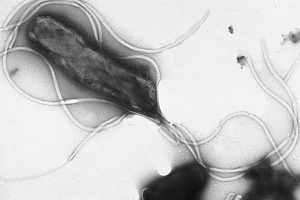Helicobacter pylori as a causative agent of Gastric Cancer: Difference between revisions
| Line 11: | Line 11: | ||
[[Image:http://upload.wikimedia.org/wikipedia/commons/9/9a/H_pylori_virulence_factors_en.png|thumb|300px|right|Figure 5. <i>H. pylori</i> virulence factors.]] | [[Image:http://upload.wikimedia.org/wikipedia/commons/9/9a/H_pylori_virulence_factors_en.png|thumb|300px|right|Figure 5. <i>H. pylori</i> virulence factors.]] | ||
<br> <br> | <br> <br> | ||
Revision as of 17:44, 22 April 2015
Introduction
Helicobacter pylori Description and Genome
Gastric Cancer
Symptoms and Treatment
Process of Infection
Adhesin
DNA Repair Pathways
Inflammation
Future Work
References
[1] Helicobacter pylori and Cancer. (2013, September 5). Retrieved April 17, 2015, from http://www.cancer.gov/cancertopics/causes-prevention/risk/infectious-agents/h-pylori-fact-sheet
[2] Machado, A. M. D., Figueiredo, C., Touati, E., Máximo, V., Sousa, S., Michel, V., & Rasmussen, L. J. (2009). Helicobacter pylori infection induces genetic instability of nuclear and mitochondrial DNA in gastric cells. Clinical Cancer Research, 15(9), 2995-3002.
[3] Suganuma, M., Watanabe, T., Yamaguchi, K., Takahashi, A., & Fujiki, H. (2012). Human gastric cancer development with TNF-α-inducing protein secreted from Helicobacter pylori. Cancer letters, 322(2), 133-138.
[4] Kim, S. S., Ruiz, V. E., Carroll, J. D., & Moss, S. F. (2011). Helicobacter pylori in the pathogenesis of gastric cancer and gastric lymphoma. Cancer letters ,305(2), 228-238.
[5] Helicobacter and Cancer Collaborative Group. Gastric cancer and Helicobacter pylori: A combined analysis of 12 case control studies nested within prospective cohorts. Gut 2001; 49(3):347–353.
[6] Maier, R. J., Fu, C., Gilbert, J., Moshiri, F., Olson, J., & Plaut, A. G. (1996). Hydrogen uptake hydrogenase in Helicobacter pylori. FEMS microbiology letters, 141(1), 71-76.
[7] Ottemann, K. M., & Lowenthal, A. C. (2002). Helicobacter pylori uses motility for initial colonization and to attain robust infection. Infection and immunity, 70(4), 1984-1990.
[8] D. Falush, T. Wirth, B. Linz, et. al., Traces of human migrations in Helicobacter pylori populations, Science 299 (2003).
[9] A. Dubois, T. Boren, Helicobacter pylori is invasive and it may be a facultative intracellular organism. Cell Microbiol. 9 (2007).
[10] Mayo Clinic. (n.d.). Stomach Cancer. Retrieved April 17, 2015, from http://www.mayoclinic.org/diseases-conditions/stomach-cancer/basics/definition/con-20038197
[11] Stomach Cancer. (n.d.). Retrieved April 20, 2015, from http://www.mayoclinic.org/diseases-conditions/stomach-cancer/basics/treatment/con-20038197
[12] National Cancer Institute. (n.d.). Stomach Cancer: MedlinePlus. Retrieved April 17, 2015, from http://www.nlm.nih.gov/medlineplus/stomachcancer.html
[13] R.M. Peek Jr., M.J. Blaser, Helicobacter pylori and gastrointestinal tract adenocarcinomas, Nature 2 (2002) 28-37
[14] Bagnoli F, Buti L, Tompkins L, Covacci A, Amieva MR. Helicobacter pylori CagA induces a transition from polarized to invasive phenotypes in MDCK cells. Proceedings of the National Academy of Science USA 2005; 102(45):16339–16344.
[15] André AR, Ferreira MV, Mota RM, et al. Gastric adenocarcinoma and Helicobacter pylori: Correlation with p53 mutation and p27 immunoexpression. Cancer Epidemiology 2010; 34(5):618–625.
[16] Ma JL, Zhang L, Brown LM, et al. Fifteen-year effects of Helicobacter pylori, garlic, and vitamin treatments on gastric cancer incidence and mortality. Journal of the National Cancer Institute 2012; 104(6):488-492.
Edited by Alexandra Kruse, student of Joan Slonczewski for BIOL 238 Microbiology, 2015, Kenyon College.

